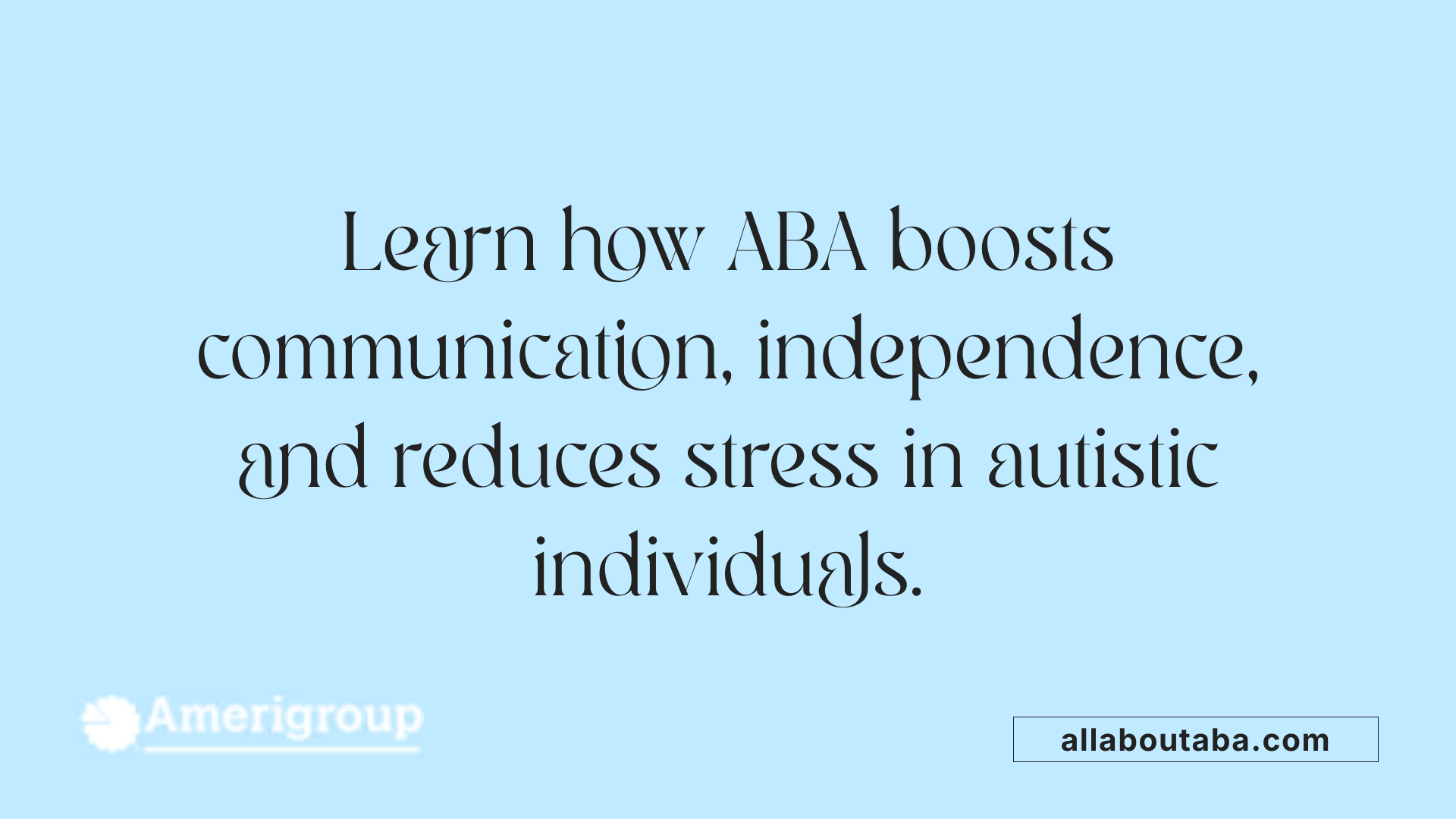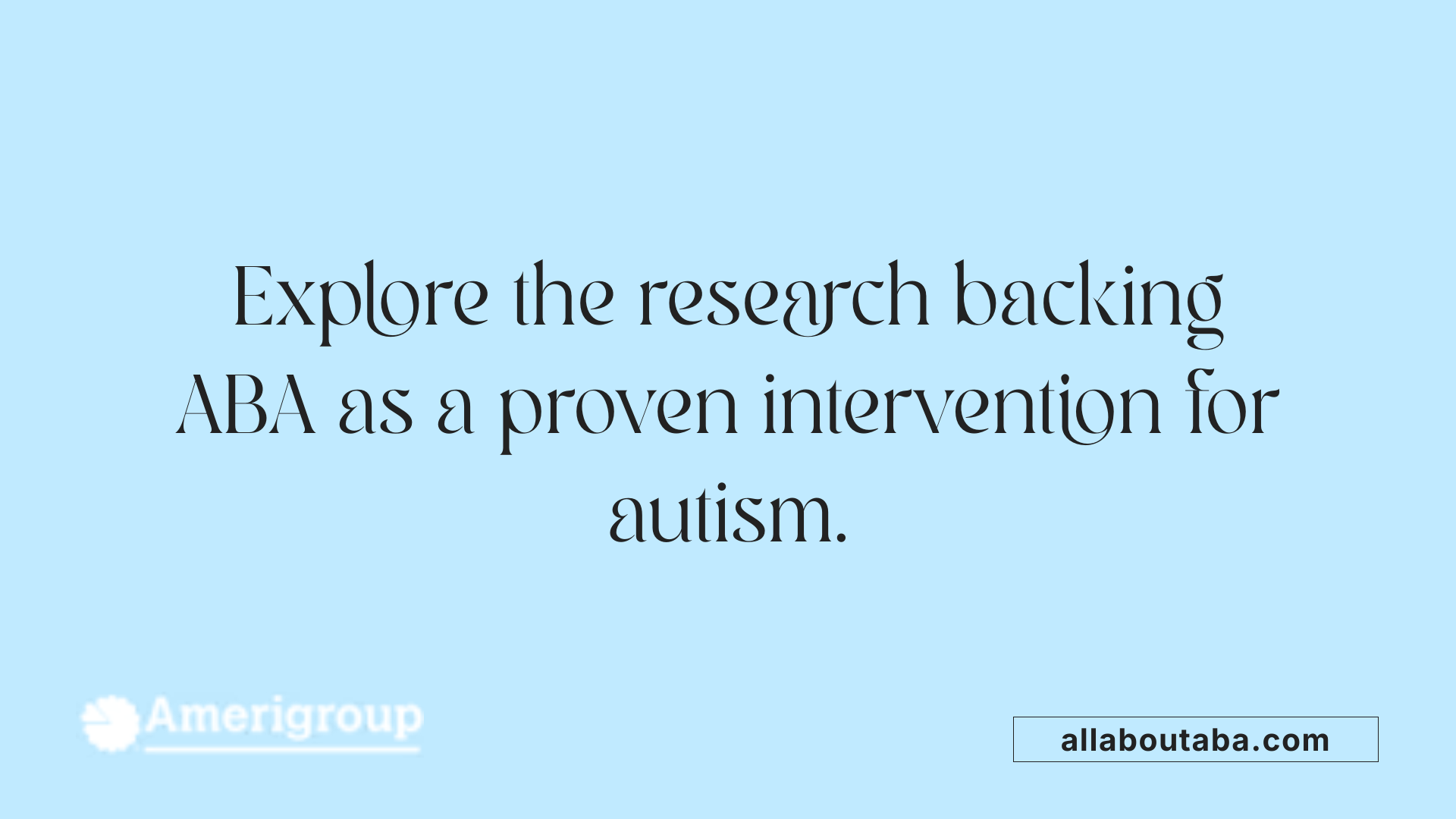Understanding Stress in Autism and the Role of Self-Care
Stress in individuals with autism spectrum disorder can stem from challenges unique to their neurological and sensory processing styles, including disruptions in routine, sensory overload, and social difficulties. This article explores how structured self-care routines and evidence-based therapies like Applied Behavior Analysis (ABA) can help manage stress and improve overall well-being for autistic individuals across their lifespan, emphasizing practical strategies for stability, resilience, and emotional regulation.
What Is Applied Behavior Analysis (ABA) Therapy?

What is Applied Behavior Analysis (ABA) therapy?
Applied Behavior Analysis (ABA) therapy is a science-based treatment that focuses on understanding and modifying behaviors through applied learning principles. It aims to increase helpful behaviors like communication, social skills, and academic abilities while decreasing harmful or disruptive behaviors by using strategies such as positive reinforcement.
How are ABA treatment plans individualized?
ABA therapy involves creating personalized treatment plans tailored to each individual's unique needs and goals. These plans are developed based on thorough assessments and monitored continuously through careful data collection to track progress and adjust strategies as needed.
What core techniques does ABA employ?
ABA therapy uses various techniques that include:
- Positive reinforcement: rewarding desirable behaviors to encourage their recurrence.
- Prompting: providing cues or assistance to guide behaviors.
- Visual aids: tools like schedules or social stories to support understanding and routine.
- Structured teaching methods: such as Discrete Trial Training (DTT), which delivers instruction in small, manageable steps.
What are common types of ABA therapy approaches?
Several structured ABA approaches exist, including:
- Discrete Trial Training (DTT): focused sessions on specific skills.
- Natural Environment Teaching (NET): learning through natural everyday interactions.
- Pivotal Response Treatment (PRT): targeting motivation and responsiveness.
Who provides ABA therapy?
Qualified professionals, especially Board Certified Behavior Analysts (BCBAs), oversee ABA treatment plans. They ensure interventions are safe, effective, and aligned with the individual’s goals, coordinating with families and other specialists to provide a comprehensive support system.
How ABA Therapy Supports Autism Stress Management and Skill Development

Improving Communication and Social Skills Through ABA
Applied Behavior Analysis (ABA) therapy plays a significant role in enhancing communication and social abilities in individuals with autism. It employs structured, evidence-based techniques like positive reinforcement and behavioral modeling to teach essential life skills
Breaking Complex Behaviors into Manageable Steps
ABA breaks down complex behaviors into smaller, manageable steps. This approach allows targeted development in critical areas such as communication, social interaction, and daily living skills, making learning accessible and less overwhelming.
Promoting Independence and Self-Confidence
By reinforcing positive behaviors and teaching coping skills, ABA fosters greater independence and self-confidence. Individuals learn how to manage emotions and navigate social situations more effectively, supporting overall emotional well-being.
Data-Driven Personalized Treatment Plans
ABA therapy relies heavily on data collection to customize treatment plans. Continuous tracking of progress ensures that interventions are tailored to individual needs, optimizing outcomes and adapting strategies as necessary.
Stress Reduction Through Behavioral Modification
Besides skill development, ABA helps reduce stress by modifying behaviors that contribute to anxiety. Strategies such as visual aids, social storytelling, and behavior management techniques make routines more predictable and manageable, reducing triggers that cause distress.
| Aspect | Description | Impact |
|---|---|---|
| Communication & Social Skills | Utilizes positive reinforcement and modeling for skill development | Improved interaction and life skills |
| Behavior Breakdown | Divides tasks into simpler steps for easier learning | Less overwhelming and targeted skill acquisition |
| Independence & Confidence | Strengthens emotional regulation and coping mechanisms | Enhanced self-esteem and autonomy |
| Data-Driven Planning | Collects and analyzes data to inform personalized interventions | Higher effectiveness and tailored support |
| Stress Reduction | Applies visual schedules and behavioral strategies to minimize stress triggers | Decreased anxiety and smoother transitions |
Professional Providers And Qualifications In ABA Therapy

Who typically provides ABA therapy?
ABA therapy is mainly delivered by professionals who have specialized education and training in applied behavior analysis. The central figures are Board Certified Behavior Analysts (BCBAs), who are responsible for designing customized treatment plans and overseeing the therapy process. Under their guidance, therapists or behavior technicians conduct the actual therapy sessions, ensuring the consistent application of interventions.
These qualified practitioners usually work in environments such as specialized autism clinics, educational settings, or healthcare facilities focused on supporting individuals with autism spectrum disorder. Their coordinated efforts aim to provide personalized and effective behavioral support.
What qualifications should ABA therapists have?
Professionals providing ABA therapy typically possess significant educational credentials, including a bachelor's degree in psychology, education, or related fields, followed by advanced coursework required for BCBA certification. Achieving BCBA status involves completing graduate-level studies, supervised clinical fieldwork, and passing a certification examination.
Therapists often accumulate practical experience through supervised hours in behavioral assessment, intervention design, and progress monitoring. Maintaining certification requires adherence to ethical practice standards, continuing education, and, in many cases, state licensing.
Roles of Board Certified Behavior Analysts (BCBAs)
- Develop and design individualized treatment plans
- Supervise therapy implementation
- Train therapists and behavior technicians
- Ensure data-driven adjustments to interventions
Therapists and Behavior Technicians in Session Delivery
- Conduct day-to-day therapy sessions
- Implement behavior management techniques
- Collect data on individual progress
- Collaborate with BCBAs for modifications
Supervision and Ethical Guidelines
- BCBAs provide ongoing supervision
- Ethical standards promote client dignity and professionalism
- Regular review of treatment procedures to ensure efficacy
Settings Where ABA Therapy Is Provided
- Autism clinics and centers
- Schools and educational programs
- Private practices
- Hospitals and healthcare facilities
This combined structure of qualified providers working within professional guidelines enables ABA therapy to effectively support individuals with autism in managing stress and improving communication, behavior, and social skills.
Typical Structure and Duration of ABA Therapy Sessions

What does a typical ABA therapy session involve?
ABA therapy sessions typically consist of one-on-one interactions between the therapist and the individual with autism. The sessions focus on specific behavioral goals that are targeted through structured activities designed to improve communication, social skills, and behavior. Therapists use a variety of techniques during each session, including prompts to encourage desired responses, positive reinforcement to reward progress, and visual aids to support understanding and retention.
Consistency and routine are crucial components of ABA therapy. Regular attendance helps reinforce learned skills through repetition, which is essential for mastery. Sessions are often tailored to meet the unique needs of each individual and can take place in different settings such as the home, school, or specialized clinics. This variability helps generalize skills across environments and reduces stress and anxiety by maintaining familiarity.
Maintaining a planned schedule not only supports steady progress but also strengthens communication between therapists and families, enabling caregivers to reinforce skills naturally in day-to-day life. Flexibility in scheduling and alternative service delivery models can also help families overcome barriers to consistent participation, thereby improving the effectiveness of therapy.
How long does ABA therapy typically last?
The length of ABA therapy can vary widely depending on the individual's specific needs, goals, and developmental progress. For many children with autism, therapy programs typically span between 3 to 5 years. In intensive programs, therapy often involves 20 to 40 hours per week to accelerate skill acquisition and behavioral improvements.
A Board Certified Behavior Analyst (BCBA) typically assesses the individual to determine the appropriate duration and intensity of therapy. Factors influencing this decision include the child’s age, symptom severity, and the targeted outcomes. As the individual masters new skills, therapy sessions may become less frequent, focusing on promoting independence and ensuring that learned behaviors transfer successfully into everyday environments.
Long-term engagement and consistent, personalized ABA therapy tend to yield the most meaningful, lasting benefits for individuals with autism.
| Aspect | Details | Importance |
|---|---|---|
| Session Type | One-on-one interaction | Personalized focus on individual goals |
| Strategies Used | Prompts, visual aids, reinforcements | Supports learning and motivation |
| Consistency and Routine | Regular, planned sessions | Enhances skill mastery and reduces anxiety |
| Settings | Home, school, clinics | Promotes skill generalization across environments |
| Duration & Intensity | 3-5 years, 20-40 hours/week typical | Tailored to individual needs for best outcomes |
Scientific Evidence and Effectiveness of ABA Therapy for Autism

What is the evidence supporting ABA therapy effectiveness?
Applied Behavior Analysis (ABA) therapy boasts substantial scientific backing as an effective intervention for autism spectrum disorder (ASD). Research consistently shows that ABA improves communication, social skills, and reduces challenging behaviors by utilizing structured, data-driven reinforcement techniques tailored to individual needs.
Research support for behavior improvement and social skills
Studies involving controlled assessments and multivariate analyses indicate ABA’s ability to produce significant gains in adaptive behaviors and emotional regulation. These improvements contribute to enhanced functional skills and overall quality of life, particularly when therapy begins early in childhood.
Recommendations from major health authorities
Leading organizations such as the US Surgeon General and the American Psychological Association endorse ABA as an evidence-based best practice for autism intervention. Their recommendations highlight ABA’s role in promoting independence and social competence.
Role of parental involvement and early intervention
Parental involvement enhances ABA outcomes by reinforcing skills outside clinical settings, creating consistent environments that support learning. Early intervention amplifies benefits by addressing developmental needs during critical periods of brain plasticity.
Limitations and variability in individual outcomes
Individual responsiveness to ABA varies, influenced by factors like age, autism severity, and comorbid conditions. Critics note that therapy should respect personal preferences and avoid a one-size-fits-all approach, emphasizing ethical and person-centered implementation.
Features that contribute to successful ABA implementation
Successful ABA involves continuous assessment, individualized programming, and integrating strategies such as visual aids, prompting, and social storytelling. Trained professionals and collaboration with families optimize therapeutic progress and stress reduction.
| Aspect | Description | Impact |
|---|---|---|
| Evidence Base | Strong research supports ABA’s efficacy in behavior and social skills improvement | Validates ABA as a widely accepted intervention |
| Early Intervention | Starting ABA in early childhood improves developmental outcomes | Takes advantage of brain plasticity |
| Parental Involvement | Active family participation enhances skill generalization and consistency | Promotes sustained progress |
| Individualization | Customized programs respect individual differences and needs | Reduces frustration, increases engagement |
| Ethical Implementation | Focus on positive reinforcement and skill building | Ensures respect for autonomy and well-being |
This evidence underscores ABA therapy as a scientifically grounded and effective approach for supporting individuals with autism in improving essential life skills and managing stress through behavioral strategies.
Managing Stress Triggers Common to Autism
What Causes Stress in Individuals with Autism?
Stress in autistic individuals often arises from social situations, sensory overload, and disruptions in routine. Social interactions can be challenging due to communication difficulties and the fear of rejection. Sensory sensitivities to noise, light, touch, or smells may cause distress or anxiety, while unplanned changes to familiar routines increase frustration and can trigger shutdowns or meltdowns.
What Are the Signs of Anxiety and Depression?
Anxiety in autism may present as repetitive behaviors, irritability, avoidance, sleep disturbances, and distress related to changes in daily routines. Depression can manifest through withdrawal, loss of interest in previously enjoyed activities, changes in sleep or eating patterns, fatigue, and expressions of sadness.
How Do Sensory Sensitivities Affect Stress?
Sensory sensitivities amplify stress by making everyday environments overwhelming. Overexposure to sensory stimuli such as loud sounds or bright lights can provoke anxiety or overload. These sensory challenges often exacerbate emotional difficulties and contribute to higher stress levels.
In What Ways Do Social Rejection and Communication Difficulties Impact Mental Health?
Difficulties in social communication increase the risk of social rejection, which can lead to feelings of isolation and depression. Poor social understanding can impede forming connections, further impacting emotional well-being and stress management.
Why Are Predictable Routines and Environmental Accommodations Important?
Maintaining predictable routines helps reduce anxiety by providing stability and structure. Using visual schedules and giving advance warnings about changes prepare individuals for transitions. Environmental accommodations, such as quiet spaces, noise-cancelling headphones, or adjusted lighting, ease sensory overload, creating a calmer, supportive setting that fosters emotional regulation.
Behavioral Strategies to Alleviate Stress in Autism
What behavioral strategies are used to reduce stress in autism?
Behavioral treatments for autism often employ prevention, replacement, and response strategies to modify environments and teach new skills that help lessen stress and challenging behaviors.
How do prevention strategies like visual schedules and advanced warnings help?
Prevention strategies focus on making daily experiences more predictable. Visual schedules provide clear, visual representations of routines, helping autistic individuals anticipate what comes next. Advanced warnings about changes prepare them for transitions, reducing anxiety linked to unpredictability.
What are replacement strategies such as functional communication training and coping skills?
Replacement strategies teach new, adaptive behaviors to substitute for problematic ones. Functional communication training equips individuals with ways to express needs or frustrations effectively, while coping skills enhance self-control and resilience to stress.
How do response strategies like positive reinforcement and extinction work?
Response strategies aim to increase constructive behaviors through positive reinforcement—rewarding desired actions to encourage repetition. Extinction involves reducing problematic behaviors by withholding reinforcement. Both require careful assessment to ensure effectiveness and appropriateness.
Why is professional guidance important in applying these strategies?
Behavioral interventions must be tailored to individual needs. Professional assessment ensures strategies address the root causes of behaviors, guide correct implementation, and adjust plans based on progress, maximizing stress reduction and skill development.
| Strategy Type | Examples | Purpose |
|---|---|---|
| Prevention | Visual schedules, advanced warnings | Make routines predictable and smooth transitions |
| Replacement | Functional communication training, coping skills | Teach alternative adaptive behaviors |
| Response | Positive reinforcement, extinction | Increase positive behaviors, reduce challenging ones |
Incorporating Mindfulness and Relaxation Techniques
What is Mindfulness-Based Stress Reduction (MBSR) and how does it help?
Mindfulness-Based Stress Reduction (MBSR) is a structured program that teaches individuals how to focus on the present moment with acceptance and without judgment. For autistic individuals, MBSR and similar mindfulness programs have demonstrated effectiveness in reducing stress, anxiety, and depression. They enhance emotional regulation and improve coping skills, enabling better management of sensory overload and social challenges.
Which relaxation techniques support stress management?
Relaxation techniques such as deep breathing exercises and progressive muscle relaxation are simple yet powerful tools. Deep breathing encourages calm by slowing the heart rate and reducing tension. Progressive muscle relaxation involves tensing and then relaxing muscle groups to release bodily stress. When regularly practiced, these methods help autistic individuals control anxiety symptoms and improve overall emotional balance.
How do mindfulness and relaxation benefit emotional well-being?
Mindfulness and relaxation techniques positively impact anxiety and depression by fostering self-awareness and emotional control. They reduce feelings of overwhelm and enhance resilience by promoting a sense of calm and groundedness. This is especially valuable given that up to 50% of autistic individuals experience clinically significant anxiety, and up to 40% face depression symptoms.
How can mindfulness be integrated into self-care routines?
Integrating mindfulness into daily self-care routines might include setting aside time for guided meditation, practicing deep breathing during stressful moments, or scheduling progressive muscle relaxation sessions. Creating structured mindfulness routines alongside predictable daily schedules helps reduce anxiety related to uncertainty and sensory sensitivities. Sensory-friendly tools can further support engagement in these practices.
What therapies complement ABA for autistic adults?
Cognitive-Behavioral Therapy (CBT), Dialectical Behavior Therapy (DBT), and Acceptance and Commitment Therapy (ACT) are specialized therapies tailored for autistic adults that complement the benefits of Applied Behavior Analysis (ABA). These therapies focus on emotional regulation, interpersonal skills, and acceptance strategies, enhancing stress management and mental health outcomes when combined with mindfulness practices.
Designing Personalized Self-Care Routines for Autistic Adults
Creating self-care toolkits with sensory-friendly items
Personalized self-care begins with assembling toolkits featuring sensory-friendly items tailored to an individual's preferences—such as noise-canceling headphones, weighted blankets, or calming scents. These items can help manage sensory overload and provide comfort during stressful moments, empowering autistic adults to take control of their emotional wellbeing.
Establishing stable, predictable daily routines
Maintaining predictable routines is vital for reducing anxiety and frustration associated with disruptions. Incorporating structured daily schedules with visual aids supports executive functioning and offers stability. This predictability enhances emotional regulation and lessens the chances of shutdowns triggered by unexpected changes.
Scheduling sensory breaks and sleep hygiene practices
Incorporating regular sensory breaks allows time to decompress from environmental stimuli, preventing overwhelm. Equally important is prioritizing sleep hygiene routines—such as consistent sleep schedules and calming pre-bedtime activities—which improve overall mood and cognitive function.
Combining therapy, mindfulness, and physical activity
Integrating therapeutic approaches like Cognitive Behavioral Therapy (CBT), Dialectical Behavior Therapy (DBT), and mindfulness helps improve emotional regulation. Physical activities, including swimming, yoga, and nature walks, further support mental health by reducing anxiety and depressive symptoms. When combined within daily routines, these practices cultivate resilience and promote sustained wellbeing.
Tailoring self-care to individual sensory profiles and interests
Effective self-care respects unique sensory profiles and personal interests. Encouraging engagement in preferred activities boosts self-esteem and emotional nourishment. Customizing strategies to individual needs enhances adherence and maximizes benefits, creating a sustainable framework for managing stress and sensory challenges effectively.
Physical Activity and Its Role in Stress Management
Activities Beneficial for Reducing Anxiety and Depression
Physical activities such as swimming, yoga, dancing, and nature walks have been shown to be effective for autistic individuals in managing symptoms of anxiety and depression. These exercises provide both physical engagement and mental relaxation, helping to ease emotional distress.
Positive Effects on Emotional Well-Being and Sensory Regulation
Incorporating these activities can improve emotional well-being by reducing feelings of anxiety and depression. Additionally, they aid sensory regulation by offering calming sensory input, which can reduce sensory overload and promote stability.
Incorporating Movement into Daily Routines
Integrating physical activity into daily schedules can enhance routine predictability and contribute to stress reduction. For example, setting aside time for a nature walk or a short yoga session helps create structure while supporting emotional balance.
Complementing Behavioral and Mindfulness Strategies
Physical exercises work well alongside behavioral treatments like Applied Behavior Analysis and mindfulness practices such as deep breathing or progressive muscle relaxation. Together, these approaches form a comprehensive system for managing stress and improving overall functioning.
Encouraging Individual Interests to Boost Motivation
Selecting movement activities that align with an individual's interests increases motivation and engagement. Encouraging autistic individuals to pursue enjoyable physical activities can boost self-esteem and foster emotional well-being, reinforcing long-term benefits.
The Importance of Professional Support and Therapy Integration
Role of Counseling and Therapy in Addressing Sensory Sensitivities
Professional support such as counseling and therapy plays a crucial role in helping autistic individuals manage sensory sensitivities. Therapists can provide tailored strategies and accommodations, including the use of noise-canceling headphones, quiet zones, weighted blankets, and lighting adjustments to reduce anxiety caused by sensory overload.
Utilizing Psychological Therapies Tailored for Autism
Several specialized psychological therapies are effective for autistic adults, including Cognitive-Behavioral Therapy (CBT), Dialectical Behavior Therapy (DBT), Acceptance and Commitment Therapy (ACT), and mindfulness therapy. These therapies focus on improving emotional regulation, reducing anxiety and depression, and enhancing social skills suited to the unique needs of autistic individuals.
Combining Professional Support with Self-Care Routines
Integrating professional therapy with personalized self-care routines strengthens coping abilities. Consistent use of structured routines, sensory breaks, mindfulness practices, and therapeutic techniques fosters a stable environment where emotional resilience can develop. This combination helps manage everyday stressors and sensory challenges more effectively.
Building Emotional Resilience and Personal Growth
Therapy encourages personal growth by enhancing self-awareness and teaching adaptive coping skills. Over time, individuals build emotional resilience, which allows them to face disruptions and anxiety-provoking situations with greater confidence and calmness.
Enhancing Coping with Life’s Demands Through Therapy
Regular therapy sessions equip autistic adults with practical tools to navigate complex social, sensory, and emotional challenges. When paired with professional guidance and self-care strategies, therapy becomes an important foundation for maintaining mental health, improving daily functioning, and fostering long-term well-being.
Building Resilience Through Structured Support and Self-Care
Managing stress in autism requires a multifaceted approach that combines evidence-based therapies such as ABA with tailored self-care routines emphasizing predictability, emotional regulation, and sensory accommodations. Professional guidance ensures interventions are individualized and effective, while mindfulness, physical activity, and behavioral strategies empower autistic individuals to cope with anxiety and sensory challenges. Integrating these elements fosters greater independence, emotional resilience, and quality of life, supporting lifelong well-being and personal growth.
References
- Effective Autism Stress Management Techniques
- Treatment for Behavioral Issues in Autism
- Autism and Self-Care
- Managing Anxiety and Depression in Individuals with Autism
- Completing ABA Sessions: Why Consistency Is Key
- How to Become an Applied Behavior Analyst (ABA) Therapist
- How to Become an ABA Therapist - School of Education







